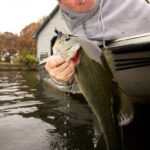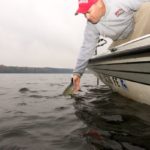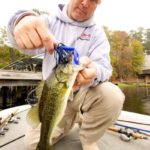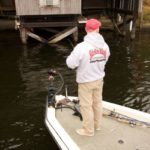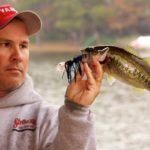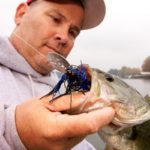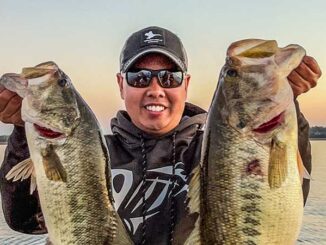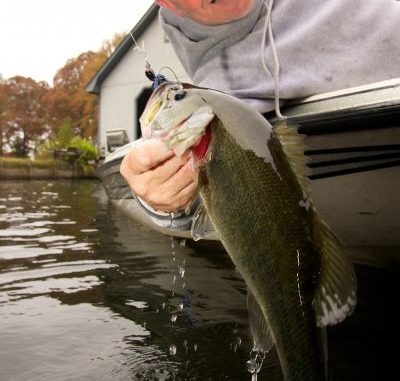
Cold water temperatures mean deepwater fishing, right? Not according to this angler, who catches big Caney Lake bass using chatter-type lures.
The last thing that comes to most people’s minds when thinking about Caney Lake is a chatter bait. Kenny Covington isn’t most people. He is a bassaholic who isn’t afraid to buck conventional wisdom. When fishing magazines instruct him to head to deep water during the middle of winter, what does Covington do? I’ll tell you what he doesn’t do. He doesn’t fish deep water.
“Out there, you’ve got to be really specific on where you’re at,” Covington said. “Up here, I’ve got a lot of different options. Out there they’ve got one.”
As strange as it sounds, he considers a chatter bait his first option at Caney Lake during January, when the water is at its coldest.
Chatter baits are made for fishing shallow water.
To put it another way, when conventional wisdom says Covington should be jigging spoons in deep water, he does the exact opposite by casting chatter-type baits in shallow water.
“Go figure,” he quipped. “I look at it like this: There are always shallow fish, even in a clear lake like Caney where hardly anybody fishes for them.”
When you throw a bait that fish have never seen at the right time in the right place it can kind of be like fishing for bass in a newly constructed pond.
“Those fish in that pond are stupid and pretty much eat anything you throw at them,” Covington explained. “Well, if I can throw a new bait to an under-fished population of bass — I think that puts the odds in my favor.”
Just last January, Covington and his tournament partner Lee King headed south to Caney Lake to throw chatter baits. Before their day was done, they landed three or four good 5- or 6-pound bass, along with numerous slot fish.
The water temperature was 51 degrees.
In fact, Covington has discovered a seemingly direct correlation when it comes to water temperature and these baits.
“The warmer it gets the worse they hit it,” he said. “I kind of got on that by accident. We found a bunch of fish last year on chatter baits in 48- to 50-degree water. By the time the tournament rolled around, the water temperature had climbed into the upper 50s, and we couldn’t buy a bite on chatter baits.
“We still caught them in the same place, but we had to switch to Rat-L-Traps.”
Although more premeditated than accidental, Covington feels he more or less stumbled into how effective chatter baits can be at Caney Lake during cold weather.
He spent a few years fishing with one of the best deepwater fishermen in all of North Louisiana for some local team tournaments, but he never felt quite at home much deeper than 3 feet of water.
“We fished every lake on the schedule deep, and Caney was no exception,” Covington said. “Then it occurred to me that I just needed to sit down and approach Caney like I did every other lake I fished by myself and figure out how to catch them shallow.”
The first thing Covington discovered was that, no matter how cold it got, the notoriously shy shallow-water bass at Caney Lake became different creatures under a cloudy sky.
“I don’t care how cold it is, if it’s cloudy overcast, the shallow fish at Caney are going to bite,” Covington insisted.
Although he had lots of options, Covington tied on a chatter bait one day just to see if it would work. Through lots of trial and error, he discovered what these unusual baits can and can not do.
The first thing this self-described power fisherman figured out was that chatter baits allowed him to cover a lot of water even when it was cold.
He also discovered that a chatter bait is a big-fish bait.
“You’re not going to catch a small 6- or 7-pound limit on a chatter bait,” he said. “It’s not a bait for catching a bunch of small fish like I’m convinced a shaky head is.”
But something a chatter bait can not do is come through wood cover without getting hung.
Over time, Covington came to the realization that a chatter bait is a cold-water version of a Wobble Head.
“What I mean by that is you either love it or hate it,” he said. “There are some people out there that aren’t going to throw it just because they think it looks strange. But if you ever pick up a Wobble Head and figure out how to fish it, you’ll surprise yourself with how good a bait it is. The same can be said of the chatter bait.”
So is it just a matter of chunking and winding a chatter bait?
You might get a few bites doing that, but Covington has figured out that a chatter bait is an extremely situation-specific lure at Caney Lake during January.
“First you’ve got to understand that a chatter bait is not a jig and it is not a spinnerbait,” he pointed out. “It’s kind of a hybrid bait that I can’t even begin to categorize, and you’re not going to be able to throw it in every kind of situation you come across.”
Covington has discovered that chatter baits work best over shallow grass flats in the backs of the creeks. Most of the grass back there during the winter consists of submerged coontail and dead lily pads.
Making as long a cast as possible, Covington reels his lure back in just fast enough to keep it ticking the top of the submerged coontail.
“I just straight retrieve it deep enough so that I can’t see it or deep enough to contact the grass,” he explained. “You can feel that blade thump, thump, thumping through there.
“When it hits the grass, I like to rip it like I would a Rat-L-Trap. That’s when I get a lot of bites.”
The key is to stay in as close contact with the blade as you can. If you can’t feel the thumping, then something is not right. Either it’s time to rip free whatever is impeding the blade from working, or it’s time to set the hook.
“A lot of times when you’re slow-rolling that thing the blade will just quit,” Covington said. “These bass will inhale it, but you won’t feel anything because they’ll hit it coming right at you and knock slack in your line.”
To help him feel bites, Covington spools his reels with 15-pound-test Seaguar Red Label fluorocarbon. Its low stretch helps him hook bass at the end of a long cast, and its increased sensitivity helps him stay in constant contact with his bait.
“Other than that, I don’t fish chatter baits on anything fancy,” he added. “A 6 ½-foot rod with a baitcasting reel works best for me. I tried fishing them on fiberglass rods, but I didn’t like it. They didn’t give me as much feel, and I couldn’t hook them when they bit after the first couple of cranks.”
As for lure sizes, Covington keeps that pretty simple, too. He prefers a ½-ounce bait because it is easier to keep it down where he can’t see it. But he will tie on a 3/8-ounce bait when he gets in grass growing just below the surface.
And although he claims he hasn’t had any problems with bass short-striking his bait, Covington insists the last thing he would do if that were the case would be to add a trailer hook.
“You can fix short strikes by playing around with size or color,” he explained. “But add a trailer hook to a chatter bait and you’re going to catch every piece of wood in the lake.”
Yes, Covington feels too many bass anglers play by the perceived rules way too often.
They read bass don’t bite in shallow, cold water, and what do they do? They head straight to Caney Lake’s famed McDonald Point.
“That’s fine with me,” Covington said, “because that leaves me all these shallow fish where I can fish more to my strengths.”
And as long as it’s cloudy and cold, he’ll throw a chatter bait shallow at Caney all day long.
It may not sound like the wisest decision, but Covington simply tunes out all the chatter that says otherwise.
